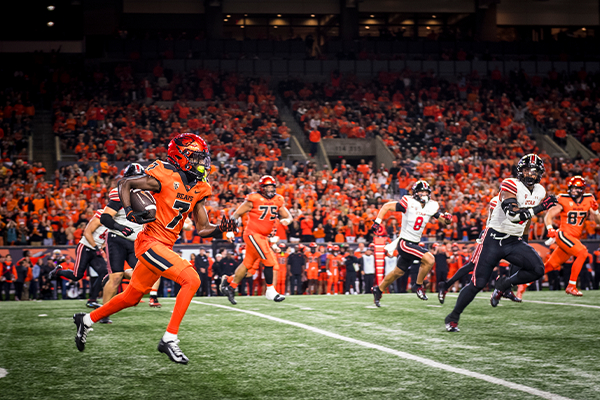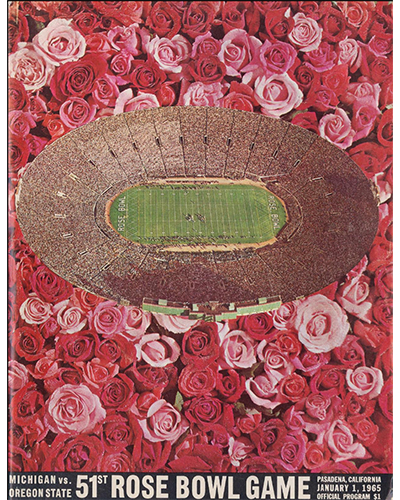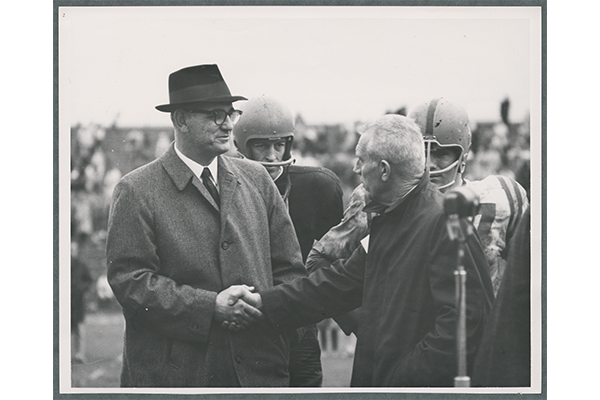The First Time the Western Conference Fell
How the breakup of the Pac-12’s predecessor echoes in today’s events
By Kip Carlson
When Oregon Staters watched the Pac-12 Conference disintegrate this summer, leaving OSU and Washington State alone in the wreckage, it seemed unprecedented: A solid part of their sporting world had crumbled. But Beavers have gone through this before.
In the late 1950s, a series of events led to the dissolution of the Pac-12’s predecessor — the Pacific Coast Conference — leaving Oregon State without a conference home for five years.
The PCC included eight of the 12 universities involved in the realignment happening now. Many issues that roiled intercollegiate athletics then are still at play, from paying players, to market sizes, to money in general.
The particulars of the PCC dissolution and the Pac-12 breakup aren’t identical: the PCC situation involved dramatic differences in institutional philosophies on governing intercollegiate athletics, and the money issue was more about ticket sales than television revenue. But the result was the same: decades of history and tradition among the West Coast’s highest-profile universities were tossed aside as a conference splintered. Then and now, an Oregon State football program that had gained national prominence was left to face an uncertain future.
The parallels offer interesting insights into the situation Beavers find themselves in today.
Scandals and subterfuge
The dominoes of the PCC’s demise began falling in 1951, when University of Oregon head coach Jim Aiken was forced to resign because of paying players and using a “Football 101” class as extra practice time.
That set off a chain reaction of allegations and dismissals. In January 1956, the University of Washington fired head coach John Cherberg; burning bridges as he left, Cherberg told the press about a booster group that paid Husky players. A round robin of finger-pointing ensued. Universities accused each other of providing outlawed extra benefits to football players, including fake work programs in which they were paid to do nothing. (At that time, the PCC did not allow athletic scholarships, while many other conferences did.) By 1957, numerous student-athletes had been declared ineligible and the conference had penalized the University of Washington, UCLA, Southern California and UC Berkeley with bowl bans and fines.
The PCC had been known as a conference that strongly valued academics above athletics, investing governing authority in its faculty athletic representatives — one faculty member from each school — rather than the athletic directors or presidents and chancellors.
“We wanted students playing at athletics, not athletes playing as students,” said Robert Sproul, UC Berkeley’s president from 1938-52 and president of the entire UC system from 1952-58.
“We wanted students playing at athletics, not athletes playing as students.”
But some fans and many in the press, particularly in Southern California, wanted to loosen the grip of the academic side. One of the leaders of the PCC’s faculty athletic representatives, the University of Oregon’s Orlando Hollis, was villainized by Los Angeles media and referred to as “Orlando Hollis, Avenging Angel and well-known inventor of unworkable athletic codes” by Ned Cronin of the Los Angeles Times.
College football historian Mark Schipper put it this way in an August interview with Portland journalist John Canzano: “The football powers saw the big stage — major-college football — while schools like Oregon, Oregon State, Washington State and at that time Idaho saw a much lower ceiling and wanted to bring the big powers down to their level.”
The conference’s larger schools were also weary of smaller Northwest schools receiving more ticket revenue from their away games than they were giving to the larger schools when they played in Corvallis, Pullman and Eugene. After USC, UCLA and California’s 1957 announcement of their intention to depart the PCC, Sports Illustrated magazine observed: “The ostensible reason for the schools’ withdrawal was the refusal of the PCC to approve their athletic policies. A more likely reason lies in the ABCs of fiscal football: the University of Michigan or, say, Oklahoma is a much better bet to fill the 100,000-plus seats in Los Angeles Coliseum than Oregon State or Washington State. After June 30, 1959, when California’s withdrawal becomes effective, the three California colleges can freely schedule the colossi of the South and Midwest to the pleasing whir of turnstiles.”
Not as big a factor as ticket sales, but quickly make inroads, was television. The first sports color telecast took place in 1951, moving sports into a whole new age. Oregon State President A.L. Strand noted in the December 1954 Oregon Stater: “Our budgets have become so dependent on such things as Rose Bowl and TV receipts that athletic directors shudder at the mere thought of losing that source of easy dollars.”
As football historian Schipper commented: “In many ways it is slightly different circumstances but a direct parallel to what’s happening today out West.”When one wouldn’t leave the other
When talk heated up in 1957 about the four California schools and Washington leaving the Pacific Coast Conference, Oregon State’s stature had risen, thanks to football Head Coach Tommy Prothro Jr., who had guided the Beavers to the 1956 PCC title and a berth in the 1957 Rose Bowl. Word on the street was that if the conference broke apart, Oregon State College — and not the University of Oregon — might be included in the new grouping.
Ted Carlson, ’50, then editor of the Oregon Stater and assistant director of the Alumni Association, heard talk both inside OSC and from contacts at other institutions that the PCC might expel the University of Oregon in retribution for faculty athletic representative Orlando Hollis’ role in the conference cheating investigation, as well as the University of Idaho for falling behind competitively.
Carlson wasn’t opposed to the idea of OSC making the leap alone and said as much in the September 1957 Oregon Stater: “Our teams are solid and strong. Our teams are representative of the largest school in the state. Naturally we like to meet the best competition we can.” That resulted in the Oregon Journal publishing a story with a banner headline reading “OSC Alumni Paper Snubs UO.”
“Any attempt to drive a wedge between Oregon State College and the University of Oregon would only hurt us both.”
The story prompted President Strand to tell the Journal, “Any attempt to drive a wedge between Oregon State College and the University of Oregon would only hurt us both. I wish to make it clear that I repudiate most of the things in the article.”
The article earned Carlson a trip to Strand’s office. After a long career teaching journalism at OSU, he is now 96 and living in Lake Oswego. “He admonished me a little bit,” Carlson recollects. This August, when the Pac-12 story broke, he was struck by the difference between then and now. “That was kind of interesting compared to what happened these days with the University of Oregon. Here President Strand was going to stick together, which he did. Old loyal Oregon State.”
An independent golden age
Competing as an independent in the early 1960s, the Beavers experienced one of the golden eras in the university’s athletic history, highlighted by Terry Baker’s 1962 Heisman Trophy and a Liberty Bowl victory; men’s basketball’s three NCAA tournament appearances and spot in the 1963 Final Four; the 1961 NCAA cross country championship; and baseball finishing in the national rankings in 1962 and 1963.
In 1962, Washington State was invited to join the AAWU, but OSU and Oregon were still on the outside. On March 31, 1964, the announcement came that the Beavers and Ducks would rejoin their former conference mates that summer and be eligible for the Rose Bowl beginning that fall. Indeed, the Beavers took the 1964 AAWU crown and a berth in the 1965 Rose Bowl.

Looking back to look forward
President Strand’s 65-year-old writings offer a perspective that might be useful to Oregon Staters viewing an uncertain future.
In the summer of 1958, Idaho President Donald Theophilus wrote the presidents of other Northwest schools urging continued scheduling ties among them; Strand responded in the affirmative, then added:
“I’ll tell you what I think is going to happen. Some of the California institutions, particularly those in L.A., will have their fling. Last night there was a UP [United Press] dispatch in the local paper. Its origin was Los Angeles. It gloated over the demise of the PCC. Now, it said, the large institutions with large stadiums can really make some money out of football … Cal, Stanford and Washington can likewise fill their stadiums. How wonderful this will be ...”
Noting that potential discord among some California schools might crack the new alignment, Strand concluded: “Nevertheless, this super-colossal virus will have to be attenuated and that will take time. After that, maybe, there’ll be hope for a new organization … Calm your fears, brother; just sit back and watch the show. It’s going to be good.”

When the PCC dissolved, Oregon State and University of Oregon stuck together as independents for nearly five years. Here, OSU Coach Tommy Prothro (left) shakes hands with Oregon Coach Len Casanova in 1962. OSU Heisman Trophy-winner Terry Baker is visible behind them.
Timeline:
Dec. 2, 1915: Representatives of Oregon State Agricultural College (now Oregon State University), the University of Oregon, the University of Washington and the University of California, Berkeley, meet in the Imperial Hotel in Portland to form the Pacific Coast Conference. Competition begins in 1916.
1917: Washington State College (now Washington State University) joins the conference.
1918: Stanford University joins the conference.
Jan. 1, 1920: Oregon falls to Harvard 7-6 in the Rose Bowl football game, beginning a string of 82 consecutive seasons in which a conference representative earns a place in the game.
1922: The University of Southern California and the University of Idaho join the conference.
1922-23: The PCC moves to a two-division format with the five Pacific Northwest schools in the North Division and the three California schools in the South Division.
1924: The University of Montana joins the conference.
1928: The University of California, Los Angeles (UCLA) joins the conference.
1933: Oregon State defeats USC to win the PCC men’s basketball championship in a best-of-three series played in the OSC men’s gymnasium.
1941: Oregon State earns the PCC berth in the Rose Bowl. Because of fears of Japan attacking the West Coast, the game is moved to Durham, N.C., and the Beavers upset heavily favored Duke, 20-16, on Jan. 1, 1942.
1950: The University of Montana leaves the conference.
1952: Oregon State defeats USC to win the PCC baseball championship in a best-of-three series in Corvallis; the Beavers go on to their first College World Series.
1955-56: The PCC drops the two-division format for basketball.
1956-1957: Oregon State wins back-to-back football titles. The Beavers win the first outright to go to the Jan. 1, 1957 Rose Bowl; the next year they share the title and would have had another Pasadena trip but for the PCC’s “no repeat” rule in place at the time.
1958: At a meeting in Portland, PCC members unanimously vote to dissolve the conference after the 1958-59 academic year after pay-for-play scandals at California, UCLA, USC and Washington become public. Those four schools, plus Stanford, then rejoin each other in the Athletic Association of Western Universities (AAWU). Oregon State, Oregon and Washington State and Idaho become independents.
1962: Washington State joins the AAWU.
1964: Oregon State and Oregon join the AAWU.
1964: In its first year in the reformed conference, OSU earns the AAWU’s berth in the Jan. 1, 1965 Rose Bowl.
1965: In its initial AAWU wrestling championship meet, OSU wins the team title, the first of its 12 titles in a 15-year span.
1967-1969: Using his technique that revolutionized the high jump, Dick Fosbury wins three consecutive conference titles; he also won the NCAA titles the last two years.
1968: The AAWU is renamed the Pacific 8 Conference.
1978: The University of Arizona and Arizona State University join the Pacific 8 and the conference is renamed the Pacific-10.
1980-82: Oregon State’s “Orange Express” wins three consecutive Pacific-10 men’s basketball titles, breaking UCLA’s string of 13 straight championships. The last team other than the Bruins to take a title was the 1966 Beavers.
1986: The Pacific-10 begins sponsoring competition in women’s sports as the NCAA becomes the national governing body for women’s athletics, replacing the Association of Intercollegiate Athletics for Women (AIAW).
1991: Oregon State wins its first Pac-10 women’s gymnastics title, the first of OSU’s four titles in a six-year stretch.
2000: Oregon State is part of a three-way tie for the Pac-10 football championship but does not get the Rose Bowl berth due to the tiebreaker in place. The Beavers settle for another New Year’s Day game, beating Notre Dame 41-9 in the Jan. 1, 2001, Fiesta Bowl.
2005-06: Oregon State wins back-to-back Pac-10 baseball titles en route to the 2005 College World Series and the 2006 national championship. The Beavers also earn a share of their first Pac-10 softball title in 2005; in 2006 they advance to the College World Series, giving OSU berths in both the baseball and softball CWS that season.
2011: The University of Colorado and the University of Utah join the conference, which becomes known as the Pac-12.
2015: Oregon State wins the Pac-12 women’s basketball championship, the first of three in a row for the Beavers. In 2016, the Beavers also win the conference tournament.
2021: Oregon State pulls off three straight upsets to win the Pac-12 men’s basketball tournament. The Beavers eventually reach the NCAA Elite Eight.
2021: Oregon State wins its first Pac-12 men’s soccer championship and is the No. 1 national seed entering the NCAA tournament.
June 30, 2022: USC and UCLA announce they will leave the Pac-12 to become members of the Big Ten on July 1, 2024.
July 27, 2023: Colorado announces it will leave the Pac-12 to become a member of the Big 12 on July 1, 2024.
Aug. 4, 2023: Oregon and Washington announce they will leave the Pac-12 to become members of the Big Ten on July 1, 2024. Later that day Arizona, Arizona State and Utah announce they will leave the Pac-12 to become members of the Big 12 on July 1, 2024.
Sept. 1, 2023: California and Stanford announce they will leave the Pac-12 to become members of the Atlantic Coast Conference. That leaves Oregon State and Washington State as the only Pac-12 members for 2024-25, with Oregon State as the only remaining original member.

